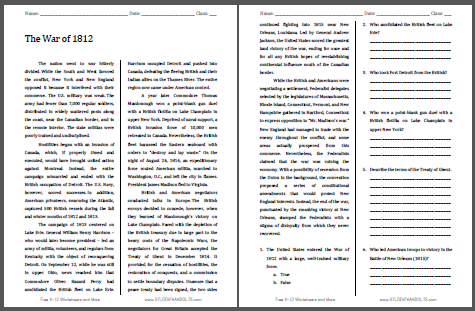The War of 1812 |
 The nation went to war bitterly divided. While the
South and West favored the conflict, New York and New England
opposed it because it interfered with their commerce. The U.S.
military was weak. The army had fewer than 7,000 regular
soldiers, distributed in widely scattered posts along the coast,
near the Canadian border, and in the remote interior. The state
militias were poorly trained and undisciplined. The nation went to war bitterly divided. While the
South and West favored the conflict, New York and New England
opposed it because it interfered with their commerce. The U.S.
military was weak. The army had fewer than 7,000 regular
soldiers, distributed in widely scattered posts along the coast,
near the Canadian border, and in the remote interior. The state
militias were poorly trained and undisciplined.Hostilities began with an invasion of Canada, which, if properly timed and executed, would have brought united action against Montreal. Instead, the entire campaign miscarried and ended with the British occupation of Detroit. The U.S. Navy, however, scored successes. In addition, American privateers, swarming the Atlantic, captured 500 British vessels during the fall and winter months of 1812 and 1813. The campaign of 1813 centered on Lake Erie. General William Henry Harrison – who would later become president – led an army of militia, volunteers, and regulars from Kentucky with the object of reconquering Detroit. On September 12, while he was still in upper Ohio, news reached him that Commodore Oliver Hazard Perry had annihilated the British fleet on Lake Erie. Harrison occupied Detroit and pushed into Canada, defeating the fleeing British and their Indian allies on the Thames River. The entire region now came under American control. A year later Commodore Thomas Macdonough won a point-blank gun duel with a British flotilla on Lake Champlain in upper New York. Deprived of naval support, a British invasion force of 10,000 men retreated to Canada. Nevertheless, the British fleet harassed the Eastern seaboard with orders to "destroy and lay waste." On the night of August 24, 1814, an expeditionary force routed American militia, marched to Washington, D.C., and left the city in flames. President James Madison fled to Virginia... |
Questions with answers in bold: 1. The United States entered the War of 1812 with a large, well-trained military force. |
| Click here to print. |
 |
|---|
Text courtesy of the U.S. State Department, Bureau of International Information Programs, 2005 |











